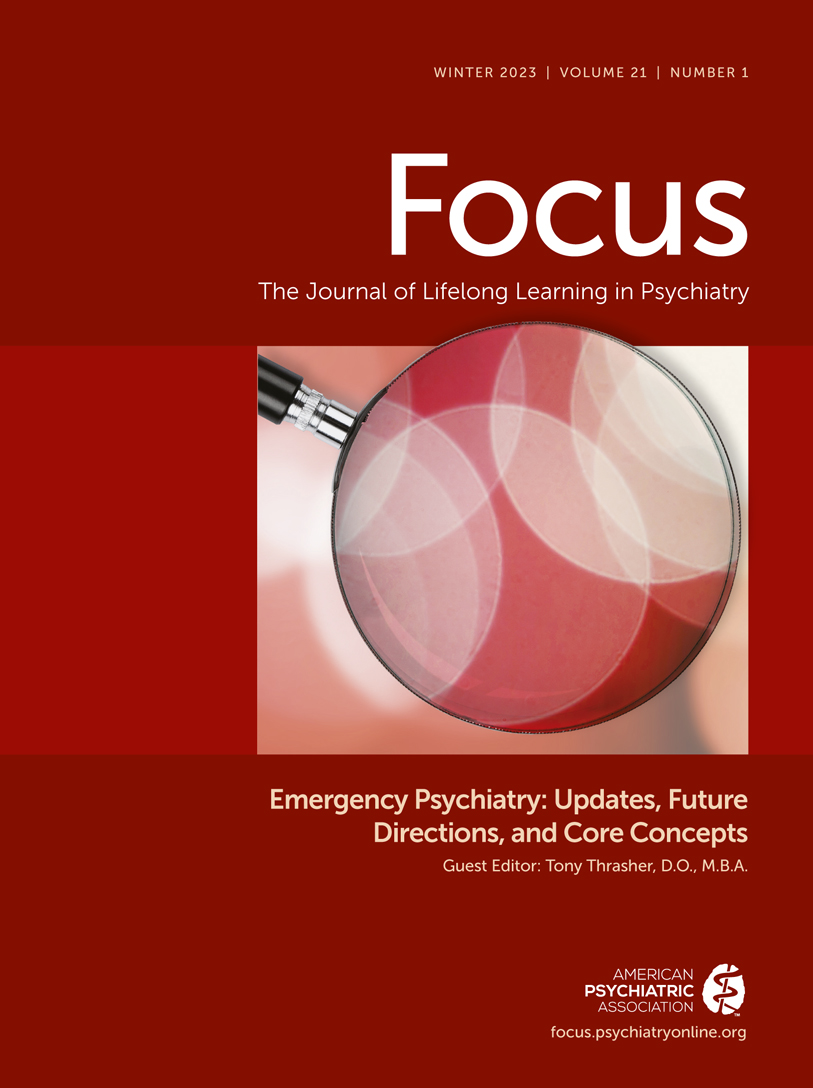Emergency Psychiatry: Updates, Future Directions, and Core Concepts
This section contains a compilation of recent publications that have shaped the thinking in the field as well as classic works that remain important to the subject reviewed in this issue. This bibliography has been compiled by experts in the field. Articles from the bibliography that are reprinted in this issue are in bold type.
: American Association for Emergency Psychiatry Task Force on Medical Clearance of Adults part I: introduction, review and evidence-based guidelines. West J Emerg Med 2017; 18:235–242Crossref, Google Scholar
: Clinical issues in the assessment of competency. Am J Psychiatry 1981; 138:1462–1467Crossref, Google Scholar
: Cops, clinicians, or both? Collaborative approaches to responding to behavioral health emergencies. Psychiatr Serv 2022; 73:658–669Crossref, Google Scholar
: Crisis Reliability Indicators Supporting Emergency Services (CRISES): a framework for developing performance measures for behavioral health crisis and psychiatric emergency programs. Community Ment Health J 2016; 52:1–9Crossref, Google Scholar
: How should physicians make decisions about mandatory reporting when a patient might become violent? AMA J Ethics 2018; 20:29–35Crossref, Google Scholar
: Risk factors proximate to suicide and suicide risk assessment in the context of denied suicide ideation. Suicide Life Threat Behav 2018; 48:340–352Crossref, Google Scholar
: Medical screening of mental health patients in the emergency department: a systematic review. J Emerg Med 2018; 55:799–812Crossref, Google Scholar
From Harm to Health: Centering Racial Equity and Lived Experience in Mental Health Crisis Response. New York, Fountain House, 2021, p 7. https://www.fountainhouse.org/assets/From-Harm-to-Health-2021.pdf Google Scholar
: Best Practices for Evaluation and Treatment of Agitated Children and Adolescents (BETA) in the emergency department: consensus statement of the American Association for Emergency Psychiatry. West J Emerg Med 2019; 20:409–418Crossref, Google Scholar
: An evaluation of crisis hotline outcomes. Part 2: suicidal callers. Suicide Life Threat Behav 2007; 37:338–352Crossref, Google Scholar
: Roadmap to the Ideal Crisis System: Essential Elements. Measurable Standards and Best Practices for Behavioral Health Crisis Response. Washington, DC, National Council for Mental Wellbeing, 2021. https://www.thenationalcouncil.org/wp-content/uploads/2022/02/042721_GAP_CrisisReport.pdf Google Scholar
: Six Core Strategies for Reducing Seclusion and Restraint Use. Alexandria, VA, National Association of State Mental Health Program Directors, 2005 Google Scholar
: Exploring bias in restraint use: four strategies to mitigate bias in care of the agitated patient in the emergency department. Acad Emerg Med 2021; 28:1061–1066Crossref, Google Scholar
: Proactive detection (PROTECT) and safety planning to shorten emergency department stays for psychiatric patients. Psychiatr Serv (Epub, Jul 7, 2022). doi: 10.1176/appi.ps.202100659Google Scholar
: The agitated older adult in the emergency department: a narrative review of common causes and management strategies. J Am Coll Emerg Physicians Open 2020; 1:812–823Crossref, Google Scholar
: Emergency psychiatric assessment, treatment, and healing (EmPATH) unit decreases hospital admission for patients presenting with suicidal ideation in rural America. Acad Emerg Med 2022; 29:142–149Crossref, Google Scholar
: Physical assault in the psychiatry emergency room. J Am Acad Psychiatry Law 2020; 48:484–495Google Scholar
: Communicating suicide risk to families of chronically suicidal borderline personality disorder patients to mitigate malpractice risk. Gen Hosp Psychiatry 2020; 67:51–57Crossref, Google Scholar
: EMTALA & psychiatric patients. DePaul J Health Care Law 2019; 21:1 Google Scholar
: Boarding of Mentally Ill Patients in Emergency Departments: American Psychiatric Association Resource Document. Washington, DC, American Psychiatric Association, 2019Google Scholar
: Medical evaluation and triage of the agitated patient: consensus statement of the American Association for Emergency Psychiatry Project BETA Medical Evaluation Workgroup. West J Emerg Med 2012; 13:3–10Crossref, Google Scholar
: The return on investment of post discharge follow-up calls for suicidal ideation or deliberate self-harm. Psychiatr Serv 2014; 65:1012–1019Link, Google Scholar
: American Association for Emergency Psychiatry recommendations to address psychiatric staff shortages in emergency settings. Psychiatr Serv 2021; 72:437–443Link, Google Scholar
: Improving the management of acutely agitated patients in the emergency department through implementation of Project BETA (Best Practices in the Evaluation and Treatment of Agitation). J Am Coll Emerg Physicians Open 2020; 1:898–907Crossref, Google Scholar
: Risk management in the emergency department: liabilities, duties, and EMTALA; in Behavioral Emergencies for Healthcare Providers. Edited by Zun LS, Nordstrom K, Wilson MP. Cham, Switzerland, Springer International Publishing, 2021 Crossref, Google Scholar
: Deaths of people with mental illness during interactions with law enforcement. Int J Law Psychiatry 2018; 58:110–116Crossref, Google Scholar
: Violence in the emergency department. Psychiatr Clin North Am 2016; 39:557–566Crossref, Google Scholar
: Identification of processes that mediate the impact of workplace violence on emergency department healthcare workers in the USA: results from a qualitative study. BMJ Open 2019; 9:e031781Crossref, Google Scholar
: What research on crisis intervention teams tells us and what we need to ask. J Am Acad Psychiatry Law 2019; 47:422–426Google Scholar
: American Association for Emergency Psychiatry Task Force on Medical Clearance of Adult Psychiatric Patients. Part II: controversies over medical assessment, and consensus recommendations. West J Emerg Med 2017; 18:640–646Crossref, Google Scholar
Jr: Feasibility of peer-delivered suicide safety planning in the emergency department: results from a pilot trial. Psychiatr Serv 2022; 73:1087–1093Crossref, Google Scholar
: Effects of a dedicated regional psychiatric emergency service on boarding of psychiatric patients in area emergency departments. West J Emerg Med 2014; 15:1–6Crossref, Google Scholar



